As part of my Walking London History Module I recently took part in a short walk around the streets of Deptford, following in the footsteps of one of Charles Booths inspectors and police officers. I had grown up in the same area in the early 1970’s but had seldom visited in recent years. Conscious that a walk around my old stomping ground could easily become just a rose-tinted trip down memory lane, I resolved to carry out a Deptford derive looking through the eyes of an historian. There is no way the whole of its wonderful history could be told in a short blog so I have chosen to pick out just a few of its many stories.
Aware that Guy DeBord and some of his situationist colleagues may have been under the influence of alcohol when they embarked on their dérive’s through 1950’s Paris, I decided that the walk I would take, should follow a similarly alcohol inspired route. In the 1980’s there were still around 12 pubs in Deptford High Street and a local tradition was to attempt to have a half a pint of beer in each of these and return to the starting point within 30 minutes. Few completed this bacchanalian challenge and those who did couldn’t remember anyway!
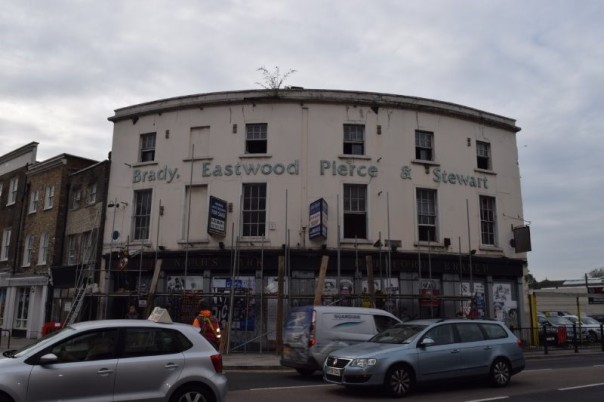
Photograph taken by self Monday 4th November 2018; Former Noah’s Ark Pub Deptford
And so, totally sober I hasten to add, I started outside my old regular haunt, the Noah’s Ark Pub at the Southern End of Deptford High Street on the junction with Evelyn Street. After a colourful encounter with the scaffolder (seen in the high viz jacket in the photo) who wanted to know “why the F- – k are you taking photos of us?”) I was minded of the problems facing the 19th Century Parisian Flaneur or the Situationists who may have encountered suspicion and mistrust by the people they observed. Rather than trying to explain the wonders of the derive and the concept of pyschogeography, I told him I was simply “taking photos of old boozers”. Happy with this explanation, I began my walk.
Alcohol has long been a part of Deptford life, as has been the struggle to try and stop Deptford people drinking. When Peter the Great visited Deptford in 1698, he and his entourage notoriously wreaked havoc at Sayers Court where they were residing, and no doubt alcohol was involved.
The Noah’s Ark shut a few years ago but has a long history, first being named around 182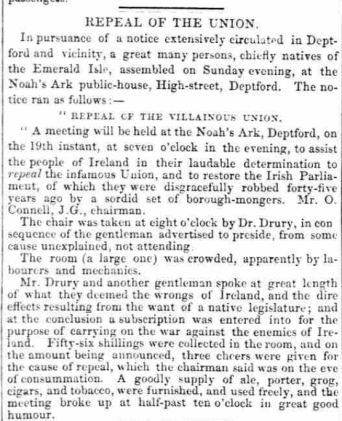 5. While many campaigners have seen pubs as the root of all working-class evil, it is easy to forget that they often had other roles in the community. The Noah’s Ark, like many other Deptford pubs, was often used as a public meeting place for less enjoyable and more serious matters; coroners’ inquests were held, and political groups would also sometimes meet. A report of in the Morning Post of 21st October 1845 records “men from the Emerald Isle” peacefully meeting at the pub to discuss the repeal of the 1800 Act of Union.
5. While many campaigners have seen pubs as the root of all working-class evil, it is easy to forget that they often had other roles in the community. The Noah’s Ark, like many other Deptford pubs, was often used as a public meeting place for less enjoyable and more serious matters; coroners’ inquests were held, and political groups would also sometimes meet. A report of in the Morning Post of 21st October 1845 records “men from the Emerald Isle” peacefully meeting at the pub to discuss the repeal of the 1800 Act of Union.
Before we leave the Noah’s Ark, it would be remiss of me in a blog about walking, not to mention this article from the Sporting Life on 1st October 1891. Before you ask, I don’t know whether he actually managed to do this. 
Moving towards Deptford Train station, I observe the wonderful but now slightly jaded architecture at this end of the High Street. Although some of the buildings now look shabby and uncared for, we still see a glimpse of Deptford High Streets Former glory. Charles Booth once referred to Deptford High Street as being the Oxford Street of the South. Garish displays and neon signs disguise the elegance of shop fronts and fine architecture. Take a short detour and you will find the Georgian Splendour of Albury Street.
Gentrification is heading Deptford’s way and perhaps property developers will finally be able to do, what a multitude of social and religious reformers failed to do? If this piece of graffiti I found in Edward Street is anything to go by, it is pleasing to see that Deptford will not go down without a fight.
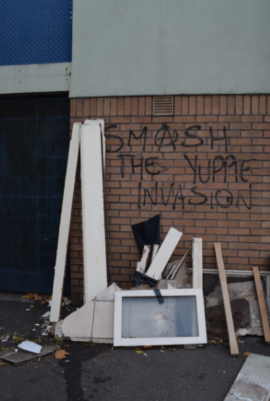
Just before the Deptford Railway station, I make a quick detour to see the magnificent St. Pauls church. This beautiful church was a huge part of my young life. I was actually baptised at this church and grew up as part of its congregation (even becoming an altar boy!). Built in 1730 by Thomas Archer, John Betjeman called it “London’s most splendiferous baroque church”. (Hornak, After the Fire p. 364).
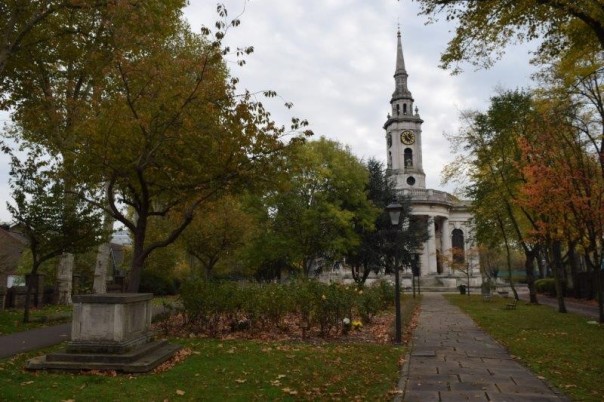
Over the years this church like many others has played an important role in the local community. As a short musical interlude, I now present you with a video made by UB40 at St. Pauls church in 1983. More information about this video can be found here and watch carefully you might just see me.
As we move further up the High Street we come to Deptford Train Station, said by some to be the oldest in London. Opposite, we see the Mechanics Arms, now an African restaurant but possibly named to recognise its proximity to the Deptford Mechanics and Literary Institute which once stood nearby. Founded in 1825, it was just one of many enterprises aimed to improve the education and behaviour of the working man. By the side of St Pauls House we see evidence of Deptford’s more recent history in the form of a painted sign directing people towards an air raid shelter. 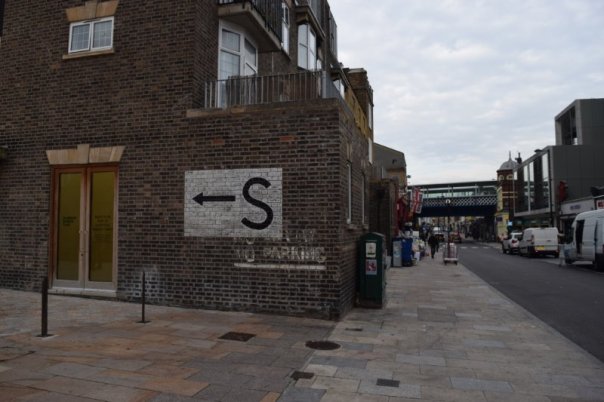
Photo taken by Neil Crossfield, 4th November 2018.
Deptford has always been an area of unrest and protest. Perhaps this is a consequence of the poverty it has experienced through its long history. Communities like those in Deptford, who have lived cheek by jowl, in poor conditions sometimes erupt in a show of protest.
Deptford’s proximity to the Docks meant it played a big role in the 1889 Dockers strike with reports of a “Deptford Mob Marching on the Metropolis”. 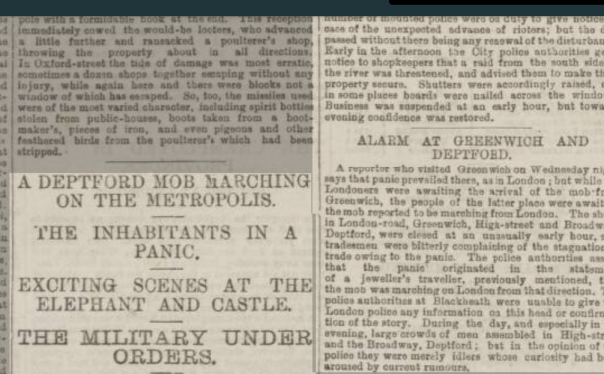
Other strikes followed in 1911 as men continued to fight for their rights. Slightly later Deptford was the scene of fierce anti-German rioting in 1914. The BBC have made this interesting podcast which you may wish to listen to. Like many areas, Deptford had a significant foreign population including many Germans and Italians. Whilst generally people may have got on, sharing the same problems as there neighbours, the advent of war ignited a spark which led to much violence. Newspapers report that crowds of 6000 or more embarked on a spree of destruction. A group of 800 or so Belgian refugees had just arrived in the area which may have helped fuel the violence.
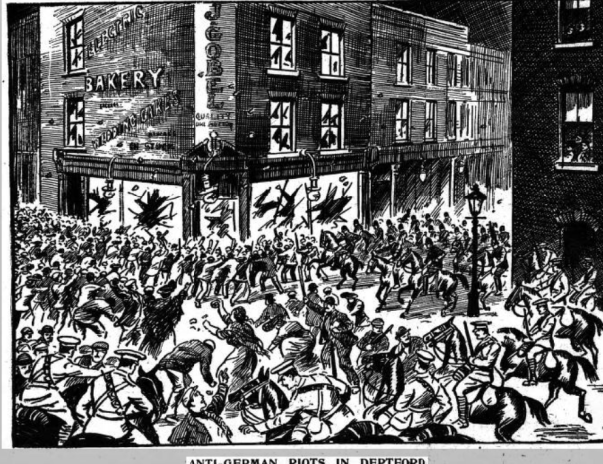 Illustration from Illustrated Police News 22nd October 1914
Illustration from Illustrated Police News 22nd October 1914
Continuing to walk up towards, Deptford Broadway, I see still more pubs which have closed down and buildings a shadow of their former self. Yet Deptford still has a real sense of colour, life and vibrancy which although it may have appalled the inspectors engaged in Charles Booths survey, it would have been recognised by the people who inhabited its street over the centuries. The nationalities have changed but in essence we can still discover elements of old Deptford if we study the area with an historians eye for detail.
Whilst most of the pubs have gone, churches are still part of the furniture of Deptford. Likewise, agencies seeking to do good work amongst the needy of the area. Deptford is now without a doubt in the crosshairs of the developers sights but whether they will be able to defeat its gritty spirit is something which remains to be seen. Before completing the walk in walked around the back of Comet Street and saw a delightful old alley next to a granary which would have be known to Booths inspectors. The High Street might be gentrified and as in Booth’s time may return to “predominately red” but scratch the surface and make a small detour and you’ll see that underneath Deptford still has areas which are “light blue to black”.
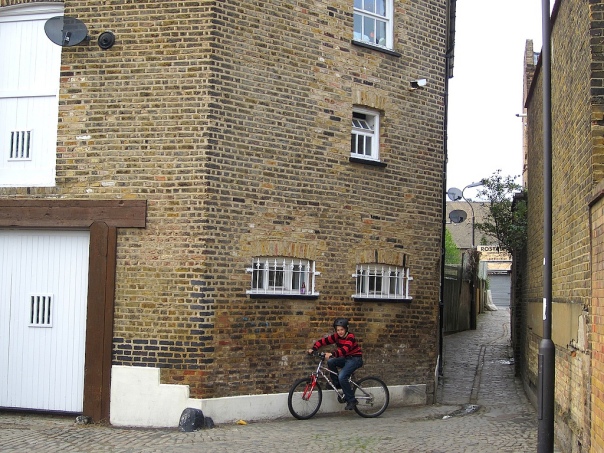
Finally reaching the top of the High Street, I realise that like the fable Deptford pub crawl of years ago, I had set myself a challenge which it would be impossible to complete in such a small space of time or in this case, in so few words. Deptford’s history needs far more research and perhaps I will get around to doing this someday. Fancy joining me? I might even buy you pint if we can find a pub which is still open.
If you want to learn more about the wonderful area of Deptford, I can highly recommend a recent BBC Documentary called “A Secret History of our Streets”
Bibliography
Joseph Bullman, Neil Hegarty and Brian Hill: A Secret History of our Streets; (BBC Books, London, 2012)
Angelo Hornak: After the Fire:London Churches in the Age of Wren, Hooke, Hawksmore and Gibbs. ( Pimpernel Press, London, 2016)
Other sources can be found by following the links.